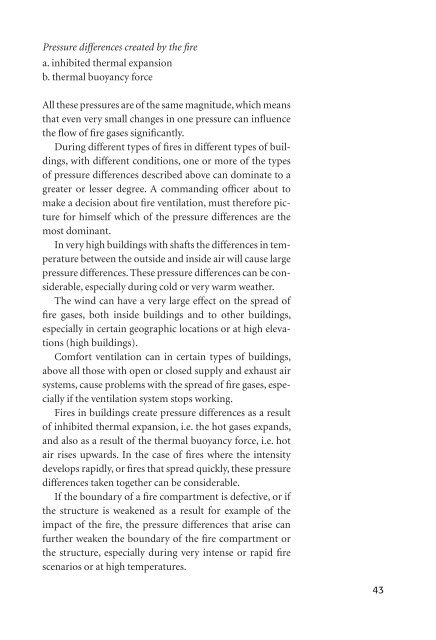Fire ventilation
Fire ventilation
Fire ventilation
Create successful ePaper yourself
Turn your PDF publications into a flip-book with our unique Google optimized e-Paper software.
Pressure differences created by the fi re<br />
a. inhibited thermal expansion<br />
b. thermal buoyancy force<br />
All these pressures are of the same magnitude, which means<br />
that even very small changes in one pressure can infl uence<br />
the fl ow of fi re gases signifi cantly.<br />
During different types of fi res in different types of buildings,<br />
with different conditions, one or more of the types<br />
of pressure differences described above can dominate to a<br />
greater or lesser degree. A commanding offi cer about to<br />
make a decision about fi re <strong>ventilation</strong>, must therefore picture<br />
for himself which of the pressure differences are the<br />
most dominant.<br />
In very high buildings with shafts the differences in temperature<br />
between the outside and inside air will cause large<br />
pressure differences. These pressure differences can be considerable,<br />
especially during cold or very warm weather.<br />
The wind can have a very large effect on the spread of<br />
fi re gases, both inside buildings and to other buildings,<br />
especially in certain geographic locations or at high elevations<br />
(high buildings).<br />
Comfort <strong>ventilation</strong> can in certain types of buildings,<br />
above all those with open or closed supply and exhaust air<br />
systems, cause problems with the spread of fi re gases, especially<br />
if the <strong>ventilation</strong> system stops working.<br />
<strong>Fire</strong>s in buildings create pressure differences as a result<br />
of inhibited thermal expansion, i.e. the hot gases expands,<br />
and also as a result of the thermal buoyancy force, i.e. hot<br />
air rises upwards. In the case of fi res where the intensity<br />
develops rapidly, or fi res that spread quickly, these pressure<br />
differences taken together can be considerable.<br />
If the boundary of a fi re compartment is defective, or if<br />
the structure is weakened as a result for example of the<br />
impact of the fi re, the pressure differences that arise can<br />
further weaken the boundary of the fi re compartment or<br />
the structure, especially during very intense or rapid fi re<br />
scenarios or at high temperatures.<br />
43

















